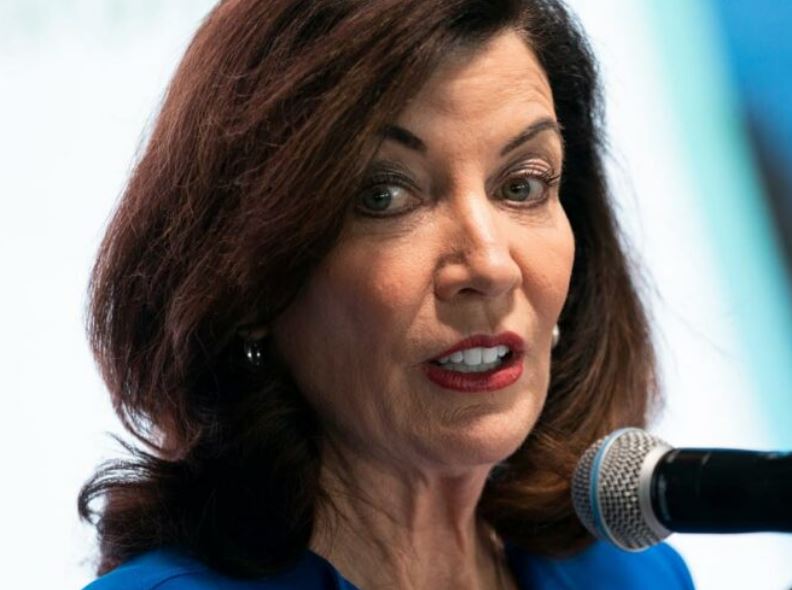New York State is doubling down on the Democrats’ efforts to ban gas appliances in Americans’ homes in order to comply with green agenda goals to “fight climate change.”
The state’s Democrat Governor Kathy Hochul released her fiscal year 2025 budget on Monday which includes provisions for her administration’s “climate” agenda.
Gov. Hochul’s proposed budget includes provisions taken directly from the NY HEAT Act, also known as the Affordable Gas Transition Act, that further curb the public’s use of natural gas in the state.
The governor’s proposed budget pushes for “responsible, equitable, and effective gas system transition planning,” according to her office.
While Hochul’s office said the proposal wouldn’t force any resident to transition away from gas, the bill would empower state regulators to indirectly push such a transition.
“The Affordable Gas Transition Act would not force any existing customers to get rid of their gas service,” a spokesperson for Hochul said in a statement.
“Governor Hochul continues to prioritize the health and safety of New Yorkers by reducing harmful emissions and ensuring all New Yorkers have continued access to affordable and reliable utility service.”
But, if passed by the state’s legislature, Hochul’s budget would require utilities to provide incentives encouraging customers to adopt green alternatives, pushing them to discontinue existing gas service.
In addition, the budget would eliminate New York’s so-called “100-foot” rule.
The rule mandates that utility providers install a gas hookup for any customer whose home is located within 100 feet of an existing pipeline.
The law has been the subject of intense criticism from environmentalists who argue it encourages new customers to rely on gas service rather than electricity.
“We applaud the Governor’s inclusion of this necessary policy, which will give the Public Service Commission the authority and direction to align gas utility regulations and system planning with the Climate Leadership and Community Protection Act,” Earthjustice, a left-wing climate advocacy organization, said in a statement.
“Importantly, it will eliminate the unjust 100-foot rule, which forces everyday New Yorkers to pay for the expansion of the gas system to the tune of more than $200 million every year,” the group added.
“It also removes a mandate to provide fossil fuel to residential customers.
“This language, which obligated utilities to serve gas to residential customers, blocked the state’s transition to healthy, inexpensive heating and cooling.”
Hochul’s proposal is the governor’s latest salvo in her fight to reduce the state’s overall carbon footprint, and greenhouse emissions generated from the building and residential sector in particular.
Last year, she reached an agreement with the state legislature to finalize a budget mandating that all new construction of smaller buildings is zero-emissions by December 2025.
It also mandates that all new construction of other buildings is zero-emissions three years later.
The mandates seek to force compliance with the World Economic Forum’s (WEF) “Net Zero” agenda.
The law, which effectively initiates a ban on gas hookups in new construction, is the first statewide law of its kind.
Hochul has also expanded the New York Power Authority’s control over renewable energy development and fossil fuel power shutdowns.
However, her actions have faced criticism from state Republicans, power providers, and labor unions who say the state isn’t ready for such a rapid transition to green energy.
Both the New York Power Authority and New York Independent System Operator warned Hochul’s plans could be detrimental to the state’s electric grid.
Unions, meanwhile, warn that there isn’t a large enough green energy supply in the state yet.
The New York State AFL-CIO, which represents millions of workers across 3,000 affiliated public sector, private sector, and building trades unions, blasted the move.
“We need to have enough alternative energy that is readily available and affordable across the state before proposals like the NY HEAT Act are considered,” Mario Cilento, the president of the New York State AFL-CIO, said in a statement.
“As of now, that is not the case.
“We believe the State of New York can lead by supporting the development of more clean energy generation alternatives, including transitioning to proven thermal energy networks,” he continued.
“This, along with strong labor standards on construction, maintenance, operations, and supply chain, will help meet the CLCPA emission reduction goals while creating good union jobs.”
Overall, in 2022, more than 58% of all New York households relied on natural gas for heating while another 17% used heating oil, according to the Energy Information Administration.
Additionally, 15% of households in the state were heated with electricity, the largest share of which was generated by natural gas power plants.
At the same time, the buildings and residential sector produces 32% of New York’s total emissions, more than any other sector, the most recent New York Department of Environmental Conservation data showed.
